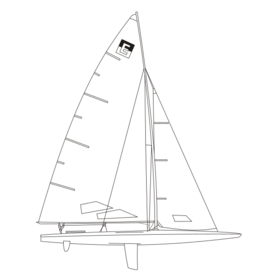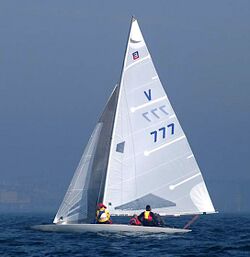Engineering:E Scow
 | |
 | |
| Development | |
|---|---|
| Designer | Arnold Meyer Sr |
| Location | United States |
| Year | 1924 |
| Builder(s) | Johnson Boat Works Melges Performance Sailboats |
| Role | One-design racer |
| Boat | |
| Crew | 3-5 |
| Boat weight | 965 lb (438 kg) |
| Draft | 3.75 ft (1.14 m) with a centerboard down |
| Hull | |
| Type | monohull |
| Construction | wood or fiberglass |
| LOA | 28.00 ft (8.53 m) |
| Beam | 6.75 ft (2.06 m) |
| Hull appendages | |
| Keel/board type | twin centerboards |
| Rudder(s) | spade-type rudder |
| Rig | |
| Rig type | Bermuda rig |
| Sails | |
| Sailplan | fractional rigged sloop |
| Mainsail area | 228 sq ft (21.2 m2) |
| Jib/genoa area | 95 sq ft (8.8 m2) |
| Spinnaker area | 550 sq ft (51 m2) |
| Total sail area | 323 sq ft (30.0 m2) |
| Racing | |
| D-PN | 73.2 |
The E Scow is an American sailing dinghy that was designed by Arnold Meyer Sr as a one-design racer and first built in 1924.[1][2]
Production
The design was initially built by Johnson Boat Works in White Bear Lake, Minnesota United States , but that company closed in 1998 and production passed to Melges Performance Sailboats, who continue to build it.[1][2][3][4][5]
Design
The E Scow is a recreational sailboat, originally built of wood and now predominantly of fiberglass sandwich construction, with wood trim. It has a fractional sloop rig with either wooden or aluminum spars and running backstays. The forestay is attached well aft of the boat's bow. The hull is a scow design, with a vertical transom, a spade-type rudder controlled by a tiller and retractable dual centerboards (also called bilgeboards). It displaces 965 lb (438 kg).[1][2]
The boat has a draft of 3.75 ft (1.14 m) with a centerboard extended. With the centerboards retracted it may be beached or transported on a trailer.[1]
For sailing the design is equipped with jib and mainsail windows for visibility, plus automatic bailers. The mainsail is controlled by an outhaul, downhaul, Cunningham, boom vang and a leach cord. Under the class rules a jib luff wire and a downhaul are permitted. The boat also has a radiused mainsheet traveler and adjustable jib tracks. Only hiking straps are permitted.[2]
The design has a Portsmouth Yardstick racing average handicap of 73.2 and is normally raced with a crew of three to five sailors.[2][5]
Operational history
The boat is supported by an active class club that organizes racing events, the National Class E Scow Association. By 1994 racing fleets were sailing in Texas, Colorado, Wisconsin, Minnesota, Michigan, New York and New Jersey.[6]
In a 1994 review Richard Sherwood wrote, "this is a very fast and sophisticated boat with a long history of development. Scows probably evolved from sharpies, and the first scows were in evidence around 1895. E Scows were born at a meeting of the Inland Lake Yachting Association in 1923. Wood has been used for many years, but since 1976 FRP has predominated."[2]
See also
References
- ↑ 1.0 1.1 1.2 1.3 McArthur, Bruce (2020). "E Scow sailboat". sailboatdata.com. https://sailboatdata.com/sailboat/e-scow.
- ↑ 2.0 2.1 2.2 2.3 2.4 2.5 Sherwood, Richard M.: A Field Guide to Sailboats of North America, Second Edition, pages 128-129. Houghton Mifflin Company, 1994. ISBN:0-395-65239-1
- ↑ McArthur, Bruce (2020). "Melges Performance Sailboats". sailboatdata.com. https://sailboatdata.com/builder/melges-performance-sailboats.
- ↑ McArthur, Bruce (2020). "Johnson Boat Works (USA) 1896 - 1998". sailboatdata.com. https://sailboatdata.com/builder/johnson-boat-works-usa.
- ↑ 5.0 5.1 Melges Performance Sailboats (2020). "The Melges E Scow". melges.com. https://melges.com/melges-e-scow/.
- ↑ McArthur, Bruce (2020). "E Scow (National Class E Scow Association)". sailboatdata.com. https://sailboatdata.com/association/e-scow-national-class-e-scow-association.
External links
 |



